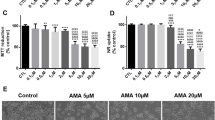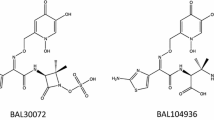Abstract
The most often used antidote to treat poisoning caused by amanitin-containing mushrooms is benzylpenicillin (BPCN). However, a very few reports suggest that other antibiotics such as ceftazidime (CEFT) and rifamycin SV (RIFSV) show better antidote activity against amanitins than BPCN. Given this, there is an ongoing debate as which of three antidotes is optimal for treatment of such poisonings. In this study, the efficacy of BPCN was compared with those of CEFT and RIFSV in human hepatocyte model. The functional integrity and viability of cultured hepatocytes was evaluated using the MTT [3-(4,5-dimethylthiazol-2-yl)-2,5-diphenyl tetrazolium bromide] assay and by measurements of lactic dehydrogenase (LDH) activity. In the first experimental layout, hepatocytes were simultaneously exposed to α-AMA and tested antidotes, while in the second layout, the cells were exposed for the first 12 h to α-AMA only, and then, the medium containing α-AMA was exchanged to culture medium containing both α-AMA and the antidotes tested. The results demonstrated that simultaneous administration of α-AMA and each of tested antidotes (BPCN, CEFT, RIFSV) effectively protected human hepatocytes; however, in the group dosed with BPCN, the highest hepatocyte viability was observed. In cell cultures from experimental layout II, all tested antidotes were ineffective, which indicates that after the critical dose of α-AMA had been taken up by hepatocytes, further suppression of this process does not protect the cells against injury. Thus, 12 h of exposure of incubated hepatocytes to α-AMA is a sufficient time for such a cellular uptake of a critical dose of this toxin. In summary, it can be concluded that easily accessible and low-cost BPCN should be widely used as an antidote against amanitins. However, the key to successful therapy is a quick implementation of an antidote in order to protect as large as possible portion of the liver parenchyma against the devastating uptake of a critical dose of amanitins.




Similar content being viewed by others
References
Abuknesha RA, Maragkou A (2004) A highly sensitive and specific enzyme immunoassay for detection of ß-amanitin in biological fluids. Anal Bioanal Chem 379:853–860
Bergamini N, Fowst G (1965) Rifamycin SV. A review. Arzneimittelforschung 15:951–1002
Bülman Laboratories (2000) Amanitin-ELISA, Instruction manual. Bülman Laboratories, Allschwil (Switzerland)
Daoudal P, Noirot A, Wagschal G, Neftel K, Hany M, Clément D, Floriot C, Delacour JL (1989) Traitement de l’intoxication Phalloidienne par Silymarine et Ceftazidime. Presse Méd 18:1341–1342
Dzierżanowska D (2009) Compendium of antibiotics. α-Medica press, Warsaw
Ellenhorn M (1997) Ellenhorn’s medical toxicology, diagnosis and treatment of human poisoning. Williams & Wilkins, Baltimore
Enjalbert A, Rapior S, Nouguier-Soule J, Guillon S, Amoroux N, Cabot C (2002) Treatment of amatoxin poisoning: 20-year retrospective analysis. J Toxicol Clin Toxicol 40:715–757
Escudié L, Francoz C, Vinel JP, Moucari R, Cournot M, Paradis V, Sauvanet A, Belghiti J, Valla D, Bernuau J, Durand F (2007) Amanita phalloides poisoning: reassessment of prognostic factors and indications for emergency liver transplantation. J Hepatol 46:466–473
Fattinger K, Cattori V, Hagenbuch B, Meier P, Stieger B (2000) Rifamycin SV and rifampicin exhibit differential inhibition of the hepatic rat organic anion transporting polypeptides, Oatp1 and Oatp2. Hepatology 32:82–86
Heilmeyer W, Plempel M, Otten H (1969) Antibiotika-Fibel. Antibiotika und Chemotherapie. Georg Thieme Verlag, Stuttgart
Heurtebize P (1990) Intoxication Phalloidienne: À Propos de Cinq Cas Traités par Ceftazidime et Silymarine. Thèse de Médicine, Université de Besançon, France
Jaeger A, Jehl F, Flesch F, Sauder P, Kopferschmitt J (1993) Kinetics of amatoxins in human poisoning: therapeutic implications. J Toxicol Clin Toxicol 31:63–80
Jan MA, Siddiqui TS, Ahmed N, Haq I, Khan Z (2008) Mushroom poisoning in children: clinical presentation and outcome. J Ayub Med Coll Abottabad 20:99–101
Krishna PS, Venkateswarlu G, Pandey A, Rao LV (2003) Biosynthesis of rifamycin SV by Amycolatopsis mediterranei MTCC17 in solid cultures. Biotechnol Appl Biochem 37:311–315
Letschert K, Faulstich H, Keller D, Keppler D (2006) Molecular characterization and inhibition of amanitin uptake into human hepatocytes. Toxicol Sci 91:140–149
Magdalan J, Pieśniewska M, Gliniak H (2007) The inhibition of α-amanitin uptake in perfused rat liver. Adv Clin Exp Med 16:353–360
Magdalan J, Ostrowska A, Piotrowska A, Gomułkiewicz A, Podhorska-Okołów M, Patrzałek D, Szeląg A, Dzięgiel P (2009) Benzylpenicillin, acetylcysteine and silibinin as antidotes in human hepatocytes intoxicated with α-amanitin. Exp Toxicol Pathol. doi:10.1016/j.etp.2009.05.03
Neftel K, Hübscher U (1987) Effects of β-lactam antibiotics on proliferating eukaryotic cells. Antimicrob Agents Chemother 31:1657–1661
Neftel KA, Waelti M, Shulthess HK, Gubler J (1984) Adverse reaction following intravenous penicillin G relate to degradation of the drug in vitro. Klin Wochenschr 62:25–29
Neftel KA, Hauser SP, Mueller MR (1985) Inhibition of granulopoiesis in vitro and in vivo by β-lactam antibiotics. J Infect Dis 152:90–98
Neftel K, Keusch G, Cottagnoud P, Widmer U, Hany M, Gautschi K, Joos B, Walt H (1988) Sind Cefalosporine bei der Intoxicationen mit Knollenblätterpilz besser wirksam als Penicillin G? Schweiz Med Wochenschr 118:49–51
Nguyen VT, Giannoni F, Dubois MF, Seo SJ, Vigneron M, Kedinger C, Bensaude O (1996) In vivo degradation of RNA polymerase II largest subunit triggered by alpha-amanitin. Nucleic Acids Res 24:2924–2929
Robinson-Fuentes VA, Jaime-Sánchez JL, García-Aguilar L, Gómez-Peralta M, Vázquez-Garcidueñas MS, Vázquez-Marrufo G (2008) Determination of α- and β-amanitin in clinical urine samples by capillary zone electrophoresis. J Pharm Biomed Anal 47:913–917
Rudd M, Luse D (1996) Amanitin greatly reduces the rate of transcription by RNA polymerase II ternary complexes but fails to inhibit some transcript cleavage modes. J Biol Chem 271:21549–21558
Schneider SM (2001) Mushrooms. In: Ford MD, Delaney KA, Ling LJ, Erickson WB (eds) Clinical toxicology. Saunders Company, Philadelphia, pp 899–909
Smith H, Lerner PI, Weinsten L (1967) Neurotoxicity and “massive” intravenous therapy with penicillin. Arch Intern Med 120:47–53
Vavricka SR, Van Montfoort J, Ha HR, Meier PJ, Fattinger K (2002) Interactions of rifamycin SV and rifampicin with organic anion uptake systems of human liver. Hepatology 36:164–172
Yildiz BD, Abbasoglu O, Saglam A, Sökmensüer C (2008) Urgent liver transplantation for Amanita phalloides poisoning. Pediatr Transplant 12:105–108
Acknowledgment
This work is a part of a project granted by Polish Ministry of Science and Higher Education (grant no. N 401 2809 33).
Author information
Authors and Affiliations
Corresponding author
Rights and permissions
About this article
Cite this article
Magdalan, J., Ostrowska, A., Piotrowska, A. et al. Comparative antidotal efficacy of benzylpenicillin, ceftazidime and rifamycin in cultured human hepatocytes intoxicated with α-amanitin. Arch Toxicol 83, 1091–1096 (2009). https://doi.org/10.1007/s00204-009-0466-3
Received:
Accepted:
Published:
Issue Date:
DOI: https://doi.org/10.1007/s00204-009-0466-3




